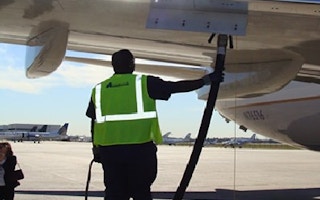Growing optimism among biofuel producers suggests companies could be producing more than 3.7 billion litres a year by 2020, as rising oil prices drive wider acceptance.
The executive director of Commercial Aviation Alternative Fuels Initiative, Richard Altman, says a poll in trade magazine Biofuels Digest revealed about 40 per cent of respondents believed the target was achievable.
Mr Altman estimated that would translate to about 10 per cent of aviation fuel used in the US if it was pumped as a 50:50 blend.
That was important to an industry aiming for carbon-neutral growth by 2020, he said.
The US expert was also encouraged by the variety of projects in the pipeline and said he knew of 13 projects in six countries, including two announced by Qantas.
But he warned there was no simple solution and, like many experts, he expected biofuel production would be decentralised and tailored to specific areas and feedstocks.
“For those who are fans of the Lone Ranger TV series: we don’t have silver bullets, we have what we call silver buckshot,” he said.
“Silver buckshot means there are lots of solutions and what’s going to be right in terms of process and feedstock will vary from country to country.
“And, in fact, in Australia, from region to region, from state to state and even within a state, it is going to be different.”
Aviation is keenly interested in biofuels as a drop-in replacement for jet kerosene and the industry has already formed national and international forums to promote the technology.
In-aircraft tests, including one involving Air New Zealand, using fuel derived from different feedstocks had provided initial confirmation that the fuels were suitable for use in jet engines.
A German process called Fischer-Tropsch has been certified for jet fuel production and the slightly delayed certification of hyrdotreated renewable jet (HRJ) fuel is expected within months. However, the stumbling block remains the ability to scale up production to commercial levels.
Important factors in reaching this goal, according to Mr Altman, include the availability of feedstock and access to a centralised distribution hub.
He also sees a need to maximise the carbon offset bang for the investment buck.
He notes that no more than 50 per cent of output from biofuel facilities will be jet fuel.
Aviation may be the main client, but plants will also produce green diesel that could be used in airport ground service equipment.
“Or if you have something like a Fedex or UPS type of system, where airfreight would disperse, you can use green diesel,” he said.
“So you want to use this concentrated distribution as a multi-modal opportunity.
“From an economic perspective, you want to make sense and get carbon credit from every ounce of everything you bring out of the plant.”
Mr Altman said work was continuing on calculating carbon lifecycle benefits. Pioneering work had been done in the US, but still needed Environmental Protection Agency approval.
The overarching role of the International Civil Aviation Organisation was an advantage for the industry that meant the rules governing aviation use did not differ between countries, he said.
“On the other hand, how you go from the ground to the fuel, it’s important that we get as common a set of rules as possible so a fuel producer who’s looking to invest in the global business can have a set of rules to work with,” he said.
Meanwhile, the industry is continuing to work on projects such as a British Airways-Solena plant in London that uses household rubbish to produce fuel, something Qantas is also investigating, and a move by Lufthansa to become the first airline operating scheduled flights partly powered by biofuel.
The delay in certifying HRJ fuel has prompted Lufthansa to put back its planned flights by at least a month, but it will ultimately run one engine on an Airbus A321 over an extended period with a 50:50 blend using fuel made from vegetable oil.
Mr Altman said such projects and the earlier one-off biofuel flights had been a plus for the aviation industry’s campaign to convince governments and the public it was ecologically responsible.
Non-government organisations were less inclined now to say the industry was not doing anything about its carbon footprint and faced a much tougher argument when they did, he said. “Aviation is going to be high-visibility no matter what,” he said.
“We’ve taken the high visibility, which has generally been a negative, and managed to turn it to a positive. One of the things we’ve learned from the flight program is that it draws attention to your industry.
“It may not be scientifically significant to fly one flight, but it certainly gets a lot of attention.”
It is proving difficult, however, to get the attention of organisations capable of funding industrial plants to produce biofuel.
USSC Dow sustainability program adjunct professor Susan Pond said biofuel projects suffered from the same capital problems that afflicted all new industries in Australia, and the manufacturing plants would be expensive — in the order of $200 million to $300m.
“That’s where we need to have international linkages and relationships,” Ms Pond said. “I don’t see all that money coming from Australia.”
Interest would emerge as banks began to build carbon desks and move “in the right direction”, she said. “What they need are credible business plans with some certainty around them.”
Offtake deals, such as that between BA and Solena, where airlines and fuel manufacturers agreed to take a certain amount of fuel, were “extremely valuable”.










